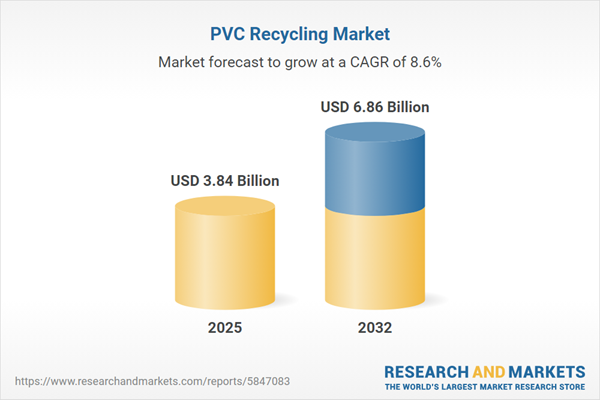Speak directly to the analyst to clarify any post sales queries you may have.
The PVC recycling market is evolving swiftly, driven by regulatory changes, technological advancements, and the urgent shift toward sustainable, circular economic models. Senior decision-makers need clear insights and actionable intelligence to navigate this complex, opportunity-rich sector.
Market Snapshot: Strong Growth and Strategic Shifts in the PVC Recycling Market
The PVC recycling market grew from USD 3.53 billion in 2024 to USD 3.84 billion in 2025. Projected to expand at a CAGR of 8.64%, the market is anticipated to reach USD 6.86 billion by 2032. This growth is anchored in rising demand for recycled materials, advancing environmental regulations, and increased attention on supply chain resilience and transparency.
Scope & Segmentation of the PVC Recycling Market
This report offers a comprehensive analysis of the PVC recycling market’s structure, including all critical factors influencing strategic planning and investment.
- Source: Post-consumer materials, such as construction waste, pipes and fittings end-of-life, and windows and doors; and post-industrial inputs, including manufacturing scrap, off-spec material, and trim scrap.
- Product Type: Flexible products (cables, wires, coated fabrics, films, medical devices) and rigid applications (pipes, fittings, profiles, sheets, films).
- Application: Automotive parts, cables and wires, flooring, medical devices, packaging, pipes and fittings, profiles.
- Technology: Feedstock recycling (catalytic gasification, steam gasification, catalytic pyrolysis, thermal pyrolysis, glycolysis, hydrolysis) and mechanical recycling (ambient pulverization, cryogenic pulverization, single-screw extrusion, twin-screw extrusion).
- Regional Coverage: Americas (United States, Canada, Mexico, Brazil, Argentina, Chile, Colombia, Peru), Europe (United Kingdom, Germany, France, Russia, Italy, Spain, Netherlands, Sweden, Poland, Switzerland), Middle East (United Arab Emirates, Saudi Arabia, Qatar, Turkey, Israel), Africa (South Africa, Nigeria, Egypt, Kenya), Asia-Pacific (China, India, Japan, Australia, South Korea, Indonesia, Thailand, Malaysia, Singapore, Taiwan).
- Companies Profiled: Veolia Environnement S.A.; SUEZ S.A.; Avangard Innovative, LLC; Remondis SE & Co. KG; Biffa plc; Van Werven Recycling B.V.; ALBA Group GmbH; Evergreen Plastics Limited; Reiling GmbH & Co. KG; Waste Management, Inc.
Key Takeaways for Senior Decision-Makers
- Regulatory pressure and corporate sustainability commitments are repositioning PVC recycling as a strategic imperative, encouraging investment beyond compliance.
- Technologies such as spectroscopy, artificial intelligence, and new chemical recycling methods are reshaping process efficiency and expanding use cases for recycled PVC.
- Supply chain transparency is gaining importance, as stakeholders—from waste collectors to end users—demand documentation of material origin and environmental impact.
- Segment differentiation requires distinct sourcing, sorting, and processing approaches to optimize value across post-consumer and post-industrial streams.
- Geographical variation in infrastructure, regulation, and end-user demand is shaping investment opportunities, particularly as regional policy frameworks and collaboration models mature.
- Market participants leveraging digital solutions and localized production networks are achieving improved feedstock security and reinforcing leadership positions.
United States Tariff Impact: Strategic Realignment in Cost Structures and Supply Chains
The introduction of additional U.S. tariffs in 2025 has elevated costs for processors sourcing recycled materials internationally, prompting manufacturers to diversify procurement strategies and reconsider supply chain layouts. These changes are fueling the establishment of new regional collection networks and encouraging joint ventures or onshore facilities to manage tariff exposures. Stakeholders are increasingly adopting creative contracting, financing, and logistics solutions to maintain market access and margin stability in response to shifting trade routes and export strategies.
Methodology & Data Sources
This report integrates primary data from structured interviews with key stakeholders such as facility operators, recyclers, manufacturers, and regulatory authorities. Secondary sources include peer-reviewed articles, policy analyses, patents, and corporate sustainability disclosures. A robust analytical framework and scenario modeling support segment-specific insights, reinforced by expert validation and cross-checked for data accuracy.
Why This Report Matters for Leadership Teams
- Benchmark your strategies against leaders’ best practices across technology, sourcing, and sustainability.
- Identify growth regions and segment-specific investment opportunities within evolving regulatory and supply chain environments.
- Leverage transparent, accurate, and actionable insights to inform risk assessment and resource allocation decisions.
Conclusion
Senior leaders operating in the PVC recycling sector should align strategy with regulatory shifts, invest in process technologies, and leverage regional opportunities for growth. Informed action now will support long-term competitiveness and innovation as the industry continues its evolution.
Additional Product Information:
- Purchase of this report includes 1 year online access with quarterly updates.
- This report can be updated on request. Please contact our Customer Experience team using the Ask a Question widget on our website.
Table of Contents
3. Executive Summary
4. Market Overview
7. Cumulative Impact of Artificial Intelligence 2025
Companies Mentioned
The companies profiled in this PVC Recycling market report include:- Veolia Environnement S.A.
- SUEZ S.A.
- Avangard Innovative, LLC
- Remondis SE & Co. KG
- Biffa plc
- Van Werven Recycling B.V.
- ALBA Group GmbH
- Evergreen Plastics Limited
- Reiling GmbH & Co. KG
- Waste Management, Inc.
Table Information
| Report Attribute | Details |
|---|---|
| No. of Pages | 192 |
| Published | October 2025 |
| Forecast Period | 2025 - 2032 |
| Estimated Market Value ( USD | $ 3.84 Billion |
| Forecasted Market Value ( USD | $ 6.86 Billion |
| Compound Annual Growth Rate | 8.6% |
| Regions Covered | Global |
| No. of Companies Mentioned | 11 |









